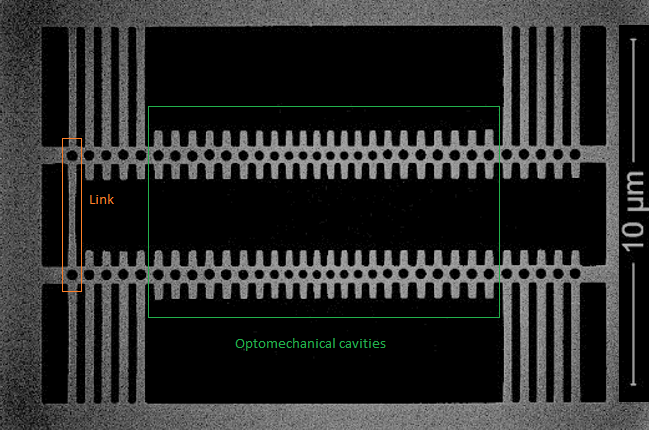Jul 5 2019
Researchers from the ICN2 Phononic and Photonic Nanostructures Group have led a research which synchronised for the first time a couple of optomechanical oscillators. This work sets a solid basis for producing reconfigurable networks of such oscillators, with potential applications in neuromorphic computing, a field of research that intends to imitate neurological structures to improve computation.

At the end of a live show, the audience requests an “Encore” under a rhythmic beat. What made rhythm emerge from the initially disperse claps? Why do flocks of birds or schools of fishes all move in unison without knowing each other’s intention? These seemingly unrelated phenomena, and many more, from the subatomic level to cosmic scales, are all the result of a phenomenon called synchronisation.
Despite being so pervasive in nature, this phenomenon was first documented in 1665, when Lord Huygens discovered that his two pendulum clocks, hung from the same structure, ended up swinging towards and away from each other regardless of their initial state, i.e., the clocks synchronised in anti-phase. The common structure from which the pendulums hang is an essential part of the system, since it transmits from one pendulum to the other the perturbations that each of them generates, causing the final synchronisation.
While it is rather straightforward to find examples at macroscopic scales, it is challenging to obtain similar results at the nanoscale. Spontaneous synchronisation between two systems requires different conditions. For instance, both of the systems must be self-sustained oscillators, meaning that they are able to generate their own rhythms, without the need of an external source. Moreover, they must synchronise due to a weak interaction, not because the systems are strongly connected.
These requirements have been fulfilled for the first time for two so-called optomechanical oscillators in a work with PhD students Martín Colombano and Guillermo Arregui, from the ICN2 Phononic and Photonic Nanostructures Group, as first authors. The research was led by ICREA Prof. Dr Clivia M. Sotomayor-Torres, Group Leader of the aforementioned ICN2 Group, and Dr Daniel Navarro-Urriós, from MIND-IN2UB and Visiting Postdoctoral Researcher at the ICN2. They are the last authors of the article published in Physical Review Letters in collaboration with Universidad de La Laguna, NEST-CNR, and Universitat Politècnica de València, within the framework of the European Commission H2020 FET Open project PHENOMEN (H2020-EU-713450).
The researchers aimed to emulate Huygens’ experiment at a scale 10 000 times smaller. To achieve this, they used two optomechanical (OM) oscillators fabricated in silicon linked by a narrow beam. Unlike Huygens’ pendulums which were driven by the mechanical motion of the clock, the OM oscillators are driven to self-sustained oscillations by means of forces exerted on them by infrared lasers. Each oscillator receives light from a different laser, reaching its own vibration frequency. However, one oscillator (the Master) is set to have stronger oscillations, i.e., with a bigger amplitude than the other (the Slave). The experiment shows that thanks to the beam linking the two oscillators, the frequency of the Slave becomes that of the Master, achieving synchronisation. The researchers were also able to control the collective dynamics, i.e., the synchronised state, by actuating over a single oscillator with another laser. If one oscillator is illuminated directly, the system goes out of the synchronised state. Removing the laser, the system spontaneously returns to synchronisation.
As the first result of its kind, this work sets a solid basis for realizing reconfigurable networks of optomechanical oscillators, in which different parts of the network could be set to perform different functions. Also, the more oscillators there are, the less noise the system generates, allowing to define better frequencies. These results may have applications in neuromorphic photonic computing, a field of research that intends to imitate neurological structures to improve computation.
Article reference:
Colombano, M. F., Arregui, G., Capuj, N. E., Pitanti, A., Maire, J., Griol, A., Garrido, B., Martinez, A., Sotomayor-Torres, C. M., Navarro-Urrios, D. Synchronization of Optomechanical Cavities by Mechanical Interaction. Physical Review Letters, 123, 017402 (2019)
DOI: https://doi.org/10.1103/PhysRevLett.123.017402